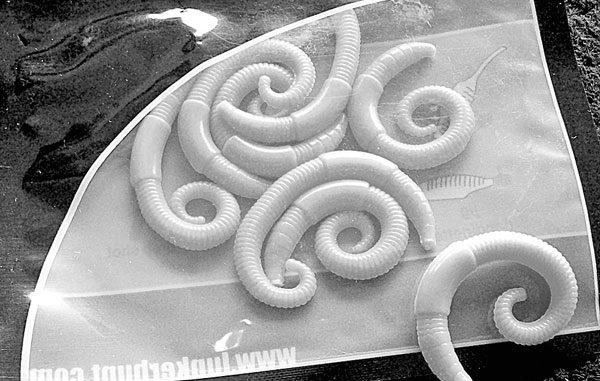
Just in time for the bream fishing bonanza in Louisiana, which my wife June and I love to indulge in along the West Atchafalaya Basin Protection Levee’s borrow pits in May, comes a package of soft-plastic earthworms from Lunkerhunt.
Lunkerhunt is an artificial-lure manufacturing company based in Canada. The company knows what it’s doing in its bid to turn out products that can catch game fish anywhere in North America.
David MacDonald of Toronto believes he has a bona fide winner in the River Worm for bream fishermen in Louisiana. The 39-year-old MacDonald — who has visited the Sportsman’s Paradise, where he has immediate family residing — is the founder of the company that has wowed ‘em north of the border and is making inroads bite by bite by bite in the U.S.
Soft-plastic earthworms? Yes. They are 2-inches long and roughly shaped in a circle a little bigger than a quarter. The perpetual bend is the key as it adds action to the soft-plastic underwater, MacDonald said.
“They’re designed with that curve. I try to give them as lifelike an appearance as possible. That curl tail gives it a lot of action. You let it do all the work. They’re really effective. Those worms are one of our top sellers,” he said.
The design gives the tail movement in the water, an appetizing sight, obviously, for the game fish that see it undulating beneath a bobber.
MacDonald designed that small soft plastic with a purpose. It is one of nearly 260 products — including soft-plastic swim baits and creature baits crafted with bass in mind — manufactured by Lunkerhunt.
“I do a lot of river fishing and panfish fishing,” he said. “(Artificial) worms I saw in the store looked lifeless, straight.”
Thus started a long period of field testing many prototypes of the River Worm. Months of field testing is a standard for the company he started in 2001 after he and his brother-in-law had a difficult time finding artificial lures that would do the job, especially in tournaments.
MacDonald, who has fished three times a week since he was 4, grew up watching fishing shows on television and reading everything he could about fishing and artificial lures in magazines. He applied what he learned to the artificial lures he designed.
He and his brother-in-law started doing well in tournaments. Soon they were making artificial lures at requests from people who learned about them by word-of-mouth and then for shops who wanted some of the action.
MacDonald branched out and started selling his products on the retail market in 2005. Diversity was one of the keys, he said, leading to the evolution of, among others, the River Worm.
“We always fish for more than just bass. The bass season (in Canada) is really short. It’ll work really well for crappie here, crappie and sunfish,” he said, noting the bass season is from July 26 to mid-December.
“You’ll be surprised. It’ll catch anything cruising the shoreline looking for a snack,” he said.
For example, four days earlier a 10-pound rainbow trout gave him a thrill after it ate a River Worm, he said.
But will it put bream and other fish in the ice chest in Louisiana?
“Oh, yeah, absolutely,” he said. “I’d imagine it’ll get bream with no problem.”
He said anglers “will be hard-pressed to tell the difference between the River Worm and the real thing.” He likes to hook it in the collar with a No. 12 or 14 hook.
The No. 1 River Worm seller as far as color is bubblegum. No. 2 is garden worm. Other available colors are dew worm, pumpkin and red worm.
The River Worm, which is manufactured in the U.S., has been on the market two years, but it isn’t on store shelves in the United States yet. Several chains, including Gander Mountain, are looking at them and other Lunkerhunt products, MacDonald said, and he has meetings scheduled this year with Academy Sports+Outdoors and Sports Authority.
Louisiana fishermen can order the River Worms at lunkerhunt.com, MacDonald said, or find out more about the product at info@lunkerhunt.com.
For more information on the River Worms and other Lunkerhunt products, call (289) 388-7370.


